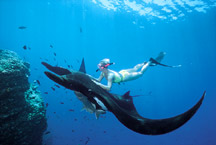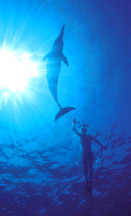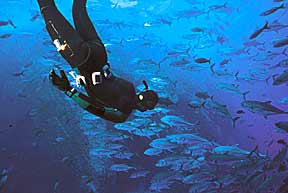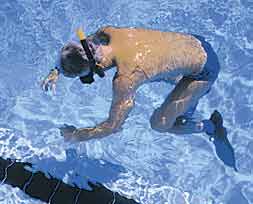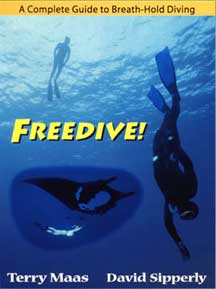|
Freediving—How
to Get Started
Soft, smooth, quiet, confident, serene, peaceful: all these adjectives hint at the intense pleasure well-trained freedivers feel. Imagine coasting below the waves, playing "drop the leaf" with wild dolphins, flying in formation with giant manta rays or simply joining a school of fish. Without a mechanical breathing apparatus, you’re truly free—free to flow effortlessly into the womb-like, enveloping water, free to join the ocean not as a interloper but as a welcome friend. A simple definition of freediving is an inch and a breath—an inch underwater on a breath of air. Snorkelers qualify but there is one more important element separating freedivers from snorkelers. It’s the feeling of true ease and relaxation under the water. You live in the moment, so absorbed that an hour spent freediving erases a week’s worries. Humans share special diving adaptations with marine mammals. The most dramatic is the "mammalian diving reflex." Simply immersing your face in cold water causes a reflexive slowing of your heart rate. This, as well as other oxygen-sparing adaptations, helps to prolong your dives. Your spleen releases extra blood cells and blood vessels in your skin and large muscles constrict, reserving blood for more vital organs, namely your heart and brain. With just a few weeks practice, you can develop your own latent freediving abilities.
While others may dive deeper and longer, a 45-second dive to 30 feet places you in the action. Since most of the ocean’s color and animal life resides within 30 feet of the surface, there’s little reason to go deeper. Forty-five seconds buys you enough time to gather game, take a photo or simply mingle as one with the fish. Best of all, the average person can master these dives in just two weeks without spending valuable travel dollars on gear. Your essentials—mask, snorkel, fins, wetsuit and weightbelt— pack easily into a duffle bag; they’re inexpensive yet eloquent enhancements to any aquatic vacation. You needn’t be an athlete to enjoy freediving because the sport is more about mind-set, technique and correct weighting than strength. Your goal is to join the water, rolling with the gentle sea surface, never fighting it. When you learn the basic surface dive, you’ll find that it takes very little energy to slip below the surface. Relaxed and confident, you choose the depth and duration of each dive. You’ll be amazed how quickly your first 15-second dives become 30 seconds, 45 seconds—long enough to dive through 30 feet.
How should you learn freediving? Not like the newlyweds I observed in Hawaii. Offering verbal support, the young man coaxed his lady into the water. Timidly she placed the unfamiliar snorkel into her mouth, flip-flopped to the reef’s edge and jumped in. In the water, she bicycled furiously with finned feet, clawed the water with her arms and made a brave attempt to look into the surging water before declaring, "I can’t!" What happened? Unfamiliar with the equipment, uncomfortable in the horizontal position, hammered by the heart-racing cold and fear of animals lurking at her feet, she panicked. Remember, freediving is about familiarity, ease, relaxation and energy conservation. To learn to freedive, find a competent, patient instructor who will guide you through the selection of your gear and who can introduce you to the basic elements of the sport in a step-wise, confidence-building fashion. Avoid advancing one step until you’re competent with the last. Select a comfortable mask and snorkel, sit by the pool’s edge and become familiar with mouth-breathing through the snorkel. Step into the pool waist deep, dip your head underwater and continue breathing. Freedivers utilize two positions, horizontal and inverted, positions not usually associated with sporting activities. Advance to the horizontal by holding the pool’s edge and floating face down. Breathe slowly and a little deeper to compensate for the useless "dead-space air" in your snorkel.
Dip your head, let a small amount of water enter your snorkel and, still breathing, slowly take in enough air to exhale rapidly—blasting the water from the snorkel tube. Take a deep breath, completely submerge your head and let the snorkel fill with water. Still looking down, raise your head level with the surface and again clear the snorkel. Later, you’ll learn to let a small amount of air escape into your snorkel as you ascend from a dive. This air will push the water out of the snorkel, making the blast unnecessary. Now you’re ready for the most important exercise in freediving: the "relaxed fetal position." The feelings and sensations you derive from this exercise provide your psychological base. It’s the state of mind you need to recall and maintain throughout your freediving career. Breathing on the surface, simply float on your stomach, curl up into the fetal position and totally relax. Some divers come close to sleep.
Freedivers use three fin strokes: the flutter, frog and dolphin. You’ll use the flutter kick most of the time. Use the frog kick, the slower of the three, to relieve cramped and tired flutter-kick muscles. The dolphin kick is great for short bursts of speed. Freedivers depend on special European-made, long, flexible fins with lots of "memory" in their resilient blades. Make sure you use short kicks and not deep leg kicks that bend the blade more than 30 degrees. When your stroke bends the blade excessively, water spills off the side and wastes energy. Take a cue from the fish—to pick up speed, use rapid small fin beats, not wide movements. The surface dive is a complex yet easily mastered maneuver. It’s basic to the sport. Once you’ve learned it, you’re free to concentrate on the finer parts of freediving: breath control, and streamlined swimming. In one fluid motion, you take a deep breath, bend at the waist, raise a leg, clear your ears and slip vertically below the surface. Like the "perfect 10" in springboard diving, only the smallest ripple should evidence your descent. To get an idea of how the surface dive works, lie on your bed, belly down. Scoot over the edge until you’re balanced at the waist. Now, lower one arm and raise the opposite leg. The weight shift sends you immediately down. In the water, initiate the dive by kicking forward to gain momentum. Fold your shoulders together to help you exhale deeply and spread them for a maximal inhalation. Bend at the waist, raise your leg and let one arm glide streamlined at your side while the other seals the nose pocket for ear clearing. Practice so that the entry results in a perfectly vertical descent. Most beginners have a tendency to shallow the angle of their dives by leading with their chests, not their finger tips. To understand the importance of streamlining, try this test. Take a yard stick and plunge it into the water at an angle with the surface. Note the resistance. Now, place the ruler on its edge and feel how easily it slips into the water.
To equalize water pressure on your ears, you need to create a counter pressure in your ears by blowing air against your sealed nose. Remember the cardinal rule of ear equalization: Clear early and often—don’t wait for pressure pain and don’t continue the dive until you have fully equalized. Don’t pinch your nose, you’ll only break the mask seal and bruise your nose. Use your fingers to seal the bottom of the nose pocket against your nostril openings and blow. Simultaneous swallowing or wiggling your jaw helps to open the air passages into your ears. Up to this point you should have been practicing in a pool and you’re probably feeling confident. There are still two more factors you need to consider before exploring the ocean. Remember our honeymooners? Beside unfamiliarity with techniques and gear, the unhappy woman had to deal with the cold and the fear of the unknown—either can ruin the dive. Management of cold might be a simple as wearing a form-fitting fabric diveskin or as complex as donning several layers of wetsuits. You need professional help to select a wetsuit, and it’s equally important that you try out the wetsuit before using it in the ocean. Ill-fitting wetsuits, especially those too tight in the chest or the neck, can send your anxiety level soaring. Get advice on weights as well. Small weights on a rubber belt work best. Make sure that you will float from water 15 feet deep. Once you’ve mastered your gear and techniques, you are ready for the ocean and the last hurdle—fear of the unknown. Can you imagine the fear-level of the honeymooner as she clawed and thrashed, unfamiliar with her gear, suddenly cold and worrying about what’s going to attack her legs? Contrast that with your first ocean entry. You’ll know how to breathe in the horizontal position. Warm and comfortable with your gear, you’ll manage water splashed into your snorkel without a second thought. Taking your instructor’s hand, you’ll swim over the reefs. Your anxiety melts with each minute as you realize that you can see what’s below and that it’s beautiful, serene and most of all—inviting. Terry Maas, author of "BlueWater Hunting and Freediving," is four times national skindiving champion. He holds world records for the bluefin and yellowfin tuna. His PBS special "Bluewater Hunters" has been viewed by over 30 million. He has just finished his second book "Freedive!" with co-author David Sipperly. Follow this link to learn more about freediving:
|
|

